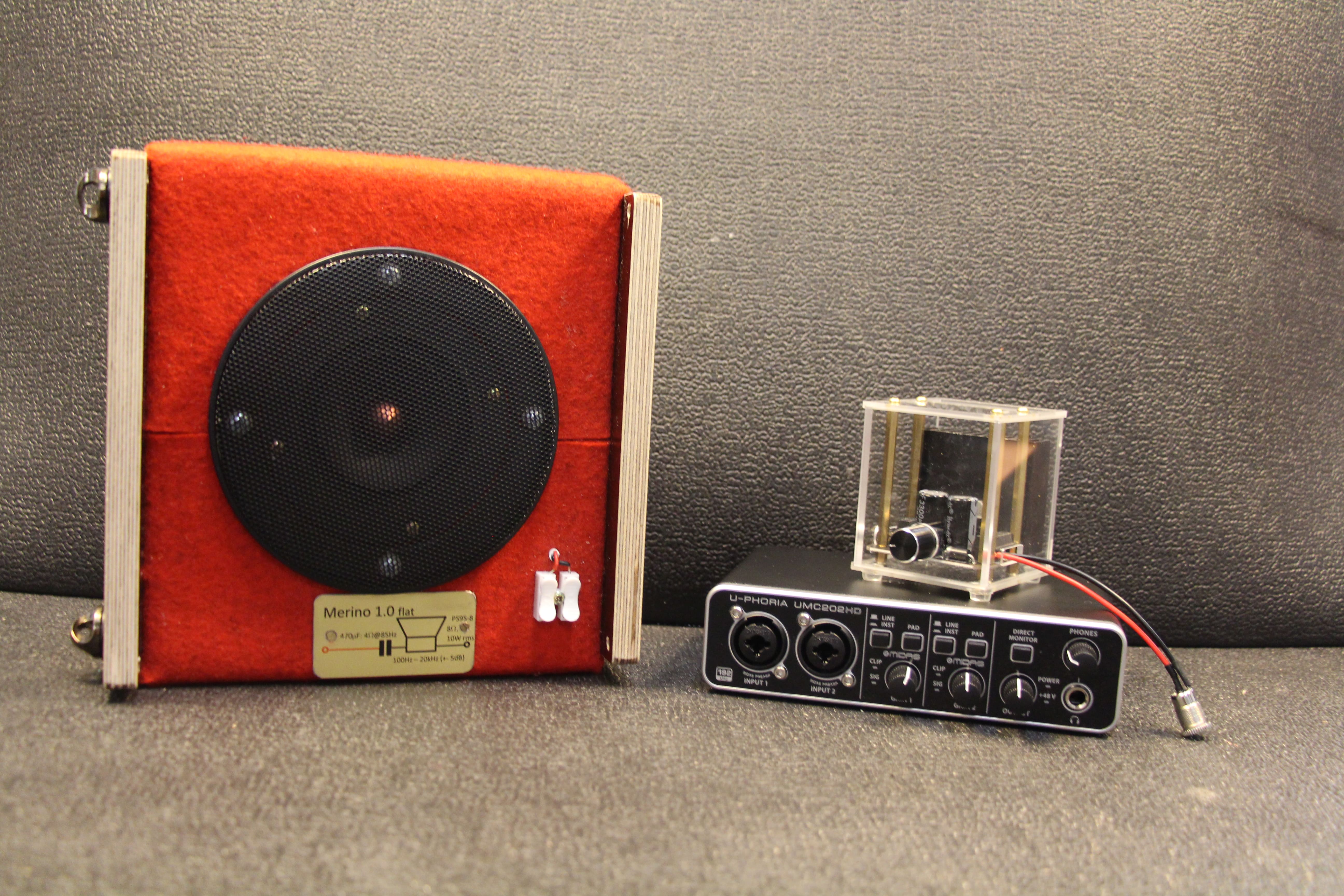The ICIR Corpus - Setup
 |
||
| Contents: | ||
Hardware
As already explained in the introductory part, the project is designed to be able to take good measurements with the most minimalist setup possible. In order to achieve this, components were chosen that we thought were affordable and yet of high quality.
Speaker
We recommend a small flat self made loudspeaker with a cabinet volume of about 1 litre. The speakers we used is the wide band Dayton PS95-8 chassis. The ‘low power’ property requires an increased length of the measurement noise files (about 20 seconds or more) to realise a reasonable signal-to-noise ratio. The small, flat loudspeaker could even serve as a very simple artificial mouth to simulate a speaker. We supply a detailed description in the appendix. It is planned to supply the cabinet data ready for a 3D plotter. The loudspeakers of the vehicle should not be used as they are already too dedicated. Furthermore, the integration of the standard loudspeakers in the test setup is more complicated, since, for example, a separate connector would have to be built for the amplifier used. The Dayton chassis was chosen because it is an inexpensive yet high quality loudspeaker with a largely linear frequency response. The data sheets are very detailed and even contain the frequency response for different directions. The housing is self-made. Care was taken to ensure that the housing is as small as possible so that the positioning of the loudspeaker is not limited by its size. In addition, there are two eyelets for loops and a thread for a tripod such as is used for cameras on the one hand. This makes it extremely easy to position the loudspeaker in almost any position in the vehicle.
The data sheets for the chassis and the construction plans for the housing can be found in the download section.
Microphone
The recommended microphone is the AKG C417. It is also very suitable for a simple set-up because it is small and can therefore simply be taped to the ceiling canopy for measurements. It also has an almost linear frequency response over 30 Hz to 20 kHz. The built-in microphones should not be used.
Amplifier
We recommend a low power amplifier of about 10 Watt rms supplied with 12 Volts from the car supply. In the appendix we show some examples.
Audio Interface
For our measurements we are using the Behringer UMC202HD because of its low price and reliable measurement results. This USB audio interface provides two inputs and two outputs. Sampling up to 192 kHz is possible with a resolution of up to 24 bit. Power supply is from USB. Several other audio interfaces are suited.
| Parts | Name | Price |
|---|---|---|
| Chassis | PS95-8, 8Ohm 10W rms | 25 € |
| Amplifier | DollaTek Mini Dual TPA3116 ZK-502H, TPA3116D2 Drok Pro, TDA 7377 |
30 € 15 € 15 € |
| Microphone | AKG C417 PP | 130 € |
| Audiointerface | Behringer UMC202HD | 45 € |
Software
The programs Arta and Audacity were mainly used to record, process and analyze the measurements. This is freeware with an extremely satisfactory range of functions. The links to the software are listed below.
Arta: https://www.artalabs.hr/index.htm
Audacity: https://www.audacity.de/
Arta is a collection of programs for measuring acoustic signals and analyzing them. Audacity is a program for recording and editing audio files. It supports the most popular audio formats and also offers some very helpful functions. For detailed documentation, please refer to the relevant websites.

 On behalf of the members of the Chair of Digital Signal Processing and System Theory, we would like to take this opportunity to wish you all a very Merry Christmas and a peaceful, restful winter break. We hope that this festive season brings you joy, relaxation, and cherished moments with your loved ones.
On behalf of the members of the Chair of Digital Signal Processing and System Theory, we would like to take this opportunity to wish you all a very Merry Christmas and a peaceful, restful winter break. We hope that this festive season brings you joy, relaxation, and cherished moments with your loved ones.